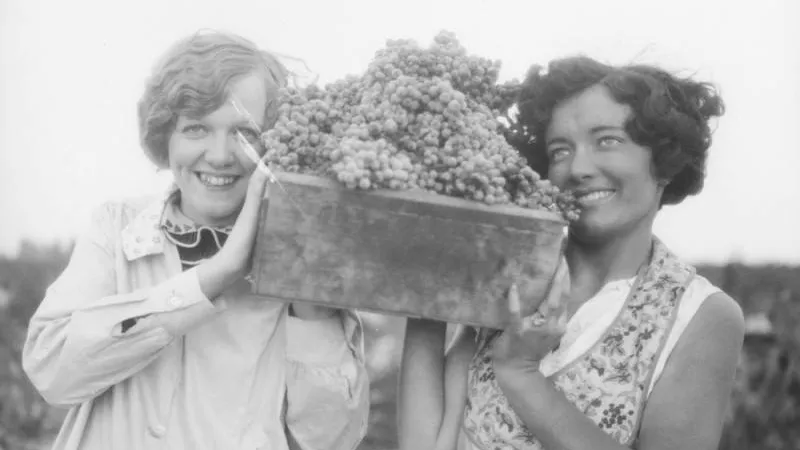The oldest tended grapevine in the United States isn't in Napa or Sonoma. It's right here, in Los Angeles County, at the San Gabriel Mission. If you're imagining rows of small, genteel vines like the ones you've seen in targeted wine tasting ads (just us?), think again. Known as the Ramona Vine, this grapevine is a mother — in more ways than one.
The Ramona Vine, which is between 260 and 270 years old, "is as big as a large tree," says filmmaker Jason Wise. "You can't wrap your arms all the way around it. This one vine covers the entire Mission in San Gabriel. So it covers the whole back, all this trellising."
Planted somewhere between 1760 and 1770, this vine has been around longer than the United States has been a nation. "It was part of two empires and two countries," Wise notes.
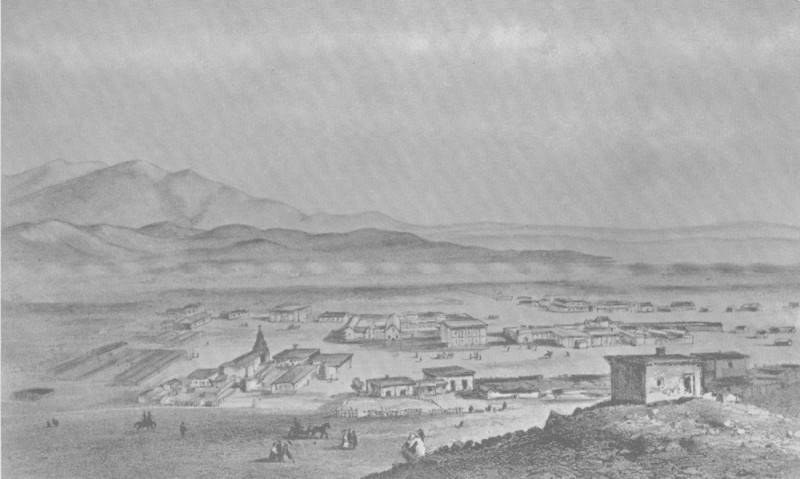
This drawing of Los Angeles, which looks toward the east from Bunker Hill to the Plaza Church, dates to the 1850s. Photo via the Security Pacific National Bank Collection/Los Angeles Public Library Collection
To get a sense of that era, you have to imagine Los Angeles before everything we see today. Before paved roads, before buildings, before all the lemon and orange orchards. Instead, imagine a landscape covered in grapevines.
"Everything from Temecula north all the way up to about the Central Valley, believe it or not, vines were one of the primary things. Koreatown exists right now in a place that would have been covered by vines. Malibu [and] a lot of the canyons in that area would have had vines covering [them] because it's pretty much the only thing you could grow there. A lot of the flat areas going out in the San Gabriel Valley were all vines, as far as you could see," Wise says.
Many of these grapes were grown, Wise explains, not just to make wine but also to ferment into a brandy or other spirits. "People drank a fair amount back then so they needed alcohol," he adds.
Wise is the director of "The Oldest Vine," a 27-minute short film about the Ramona Vine and the vintners producing wine from it. Although LA's winemaking history hasn't spent much time in the spotlight, a handful of local winemakers are doing their best to revive it.
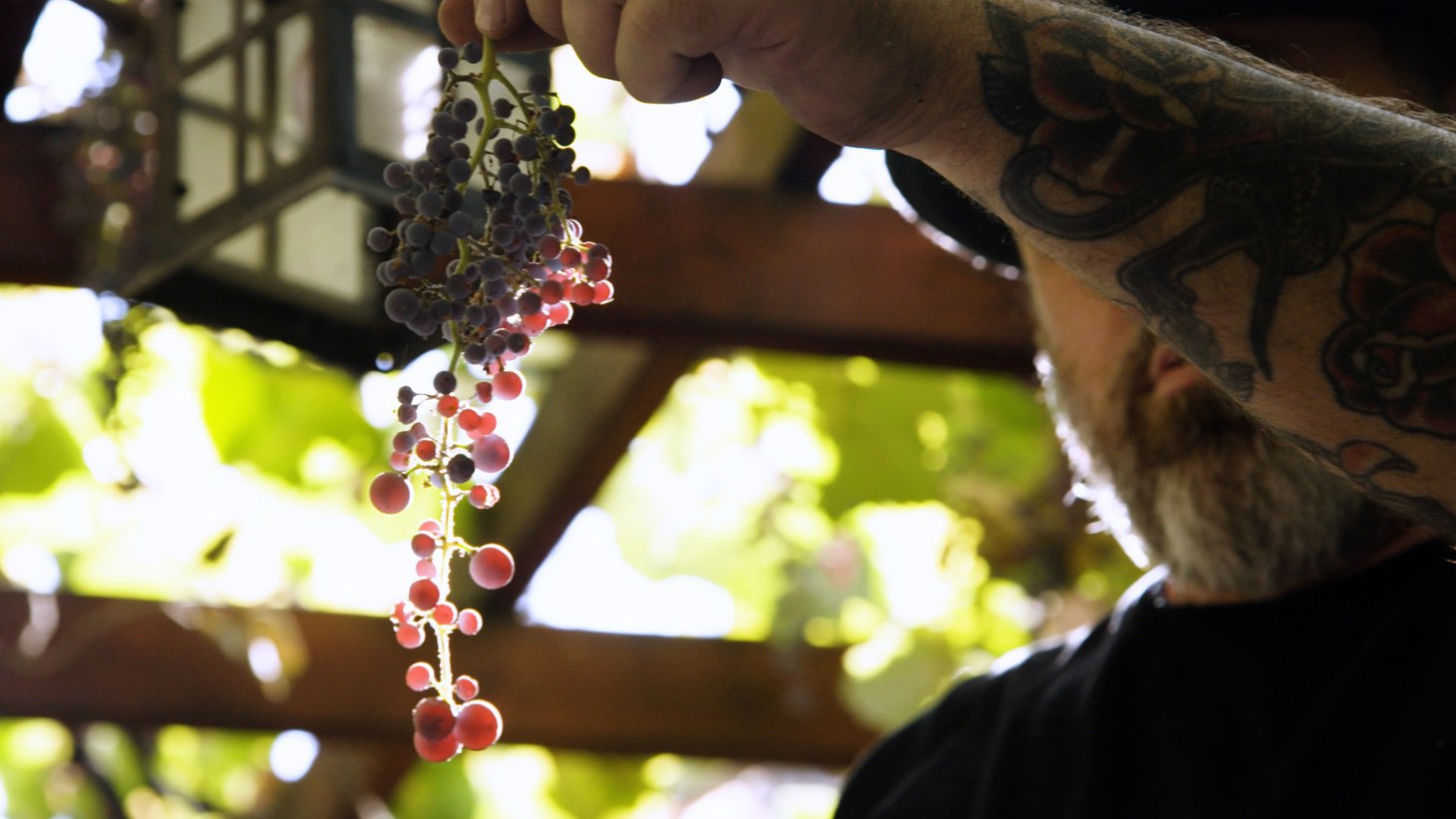
The small grapes from the oldest living vine are a hybrid of vitis vinifera (the Mission grape) and vitis girdiana (a variety native to Southern California and Baja). The vine that dates back to the 1770s. Photo courtesy of SOMM TV
Southern California became famous, in part, for its citrus orchards. But before all that, Los Angeles was known as "The City of Vines." L.A. was once home to several thriving vineyards that were well-known for their wines. Prior to Prohibition, the history of winemaking and the history in Los Angeles were almost inseparable. Winemaking was so associated with the city, the original crest for the city of Los Angeles featured grape vines and leaves.
"Los Angeles had more vines than anywhere else in the country pre-Prohibition. Before Napa, Sonoma, Santa Barbara and even the East Coast, Los Angeles was the center of wine," Wise says. He became obsessed with the idea that so few people knew about this juicy aspect of the city's history.
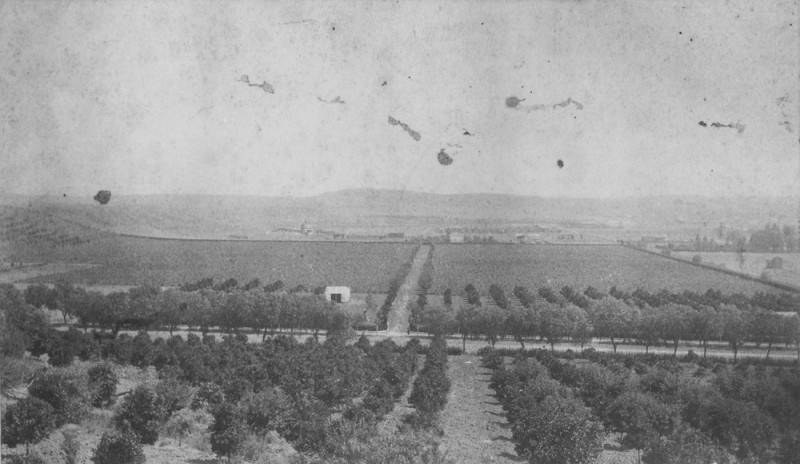
In 1865, this orchard and vineyard located at Downey Ave. and Hansen St. was put up for sale by agents L. Schmidt & Co. Photo by Frank G. Schumacher/Security Pacific National Bank Collection/Los Angeles Public Library Collection
Although most of the wine we drink is made from vitis vinifera grapes, which originally came from Europe and the Mediterranean basin, Southern California also had its own native grapes.
"Whoever planted [The Ramona Vine] was a very smart person," Wise says. "They hybridized it with an American variety and that is why it survived this long. It was very intentionally planted in this place, likely for religious reasons to have sacramental wine."
Whoever planted the vine — Wise thinks it might have been a friar, a monk or a missionary — was great at botany. "It was somebody who knew what they were doing," Wise says.
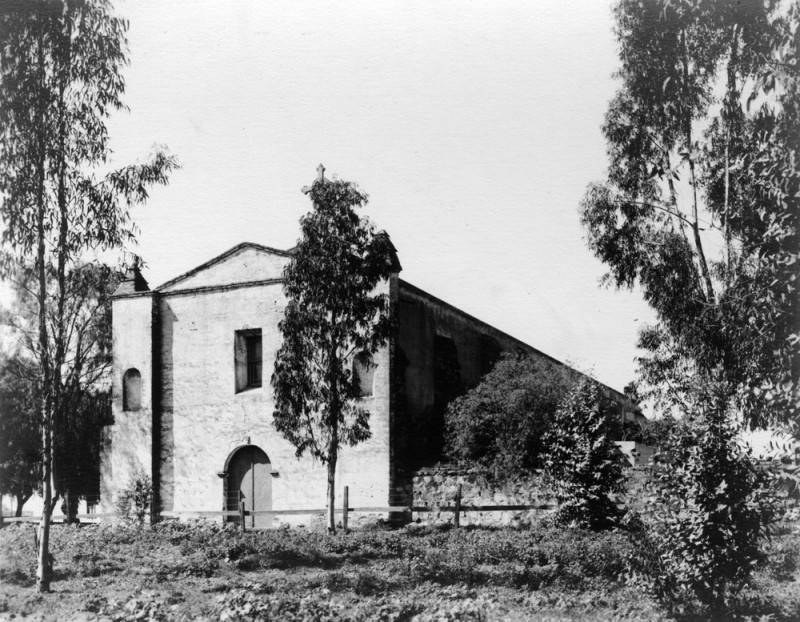
This early view of Mission San Gabriel Arcangel, aka the San Gabriel Mission, dates to 1900. Photo via the Los Angeles Public Library Collection
The vine's survival also has everything to do with the fact that it was tended by Native Americans, one of the dark legacies of California's Catholic missions. All but four of California's 21 missions grew grapes, and they needed plenty of labor to keep the juice flowing.
Most of the people taking care of mission vineyards were Native Americans. Many were forced to convert to Catholicism. They often worked in appalling conditions. They were, more or less, slaves.
As Frances Dinkelspiel, author of the 2015 book "Tangled Vines: Greed, Murder, Obsession, and an Arsonist in the Vineyards of California," writes on her website, "In working on 'Tangled Vines,' the most disturbing part of my research has been the realization that Native Americans paid the highest personal price for the development of the wine business."
Dinkelspiel goes on to say, "The Indians performed virtually all the work to make wine, from planting vines, harvesting them, and overseeing the fermentation. Yet mission rules governing their lives were so onerous Native Americans weren’t even allowed to wander the vineyards they tended without supervision. They were also forbidden to leave the missions, marry without permission, were segregated into often-squalid same-sex barracks, denied the right to raise their children and were forced to answer to a system of bells that told them when to rise, eat, pray, work, and rest. They were whipped for transgressions small and large, from stealing to wearing a dirty blanket into church."
Wise points out that the grounds of the San Gabriel Mission include several cemeteries. There's one, "right on the grounds, and the vines actually cover these ancient graves, and a lot of them are for Native Americans who were there," Wise says.
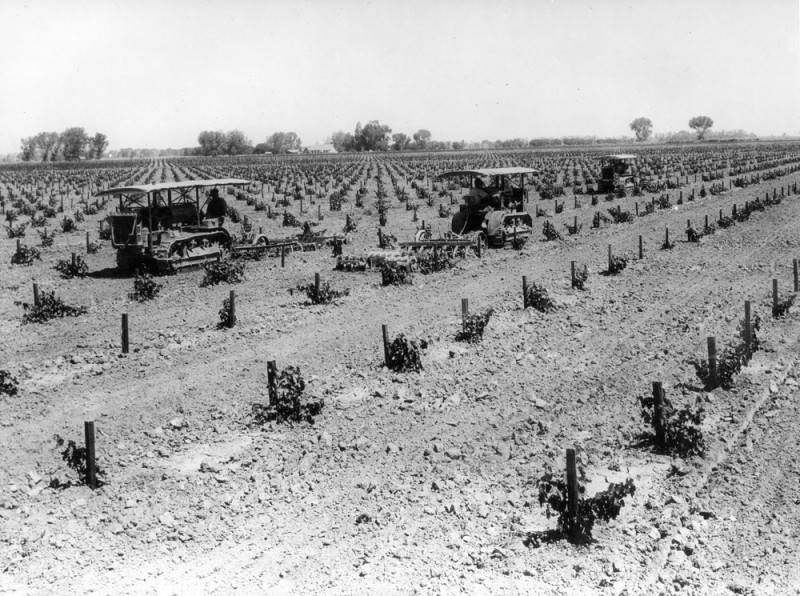
Tractors and cultivators work a Los Angeles County vineyard. Photo via the Security Pacific National Bank Collection/Los Angeles Public Library Collection
These days, the Ramona Vine is cared for by the people who preserve the San Gabriel Mission, as it has been since Prohibition. The vine has been pruned and trained to grow through a trellis, Wise explains. But for the most part, nobody had done much with these grapes — until now.
The Los Angeles Vintners Association was founded by three Los Angeles vintners — Angeleno Wine Company, Byron Blatty Wines and Cavaletti Vineyards — with the goal of "reviving and revitalizing the rich history of Los Angeles vineyards." As people who are obsessed with grapes, they heard the tale of the legendary Ramona Vine and had to see it for themselves.
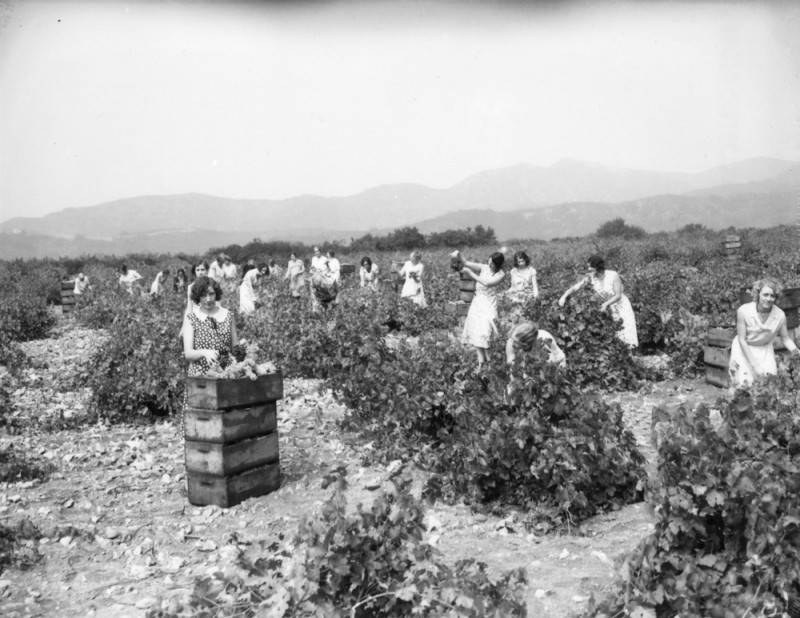
Women pick grapes in a vineyard in Burbank, circa 1928. The Verdugo Mountains are visible in the background. Photo via the Eyre Powell Chamber of Commerce Collection/Los Angeles Public Library Collection
Wise explains what happened next: "Terry, the woman who manages the Mission, said, 'We have this vine here. There are grapes on it. Would you guys like to come take a look?' So they came and took a look, and I think their jaws hit the floor. They said, 'What are you doing with the grapes?' She said, 'We just trim them and the birds eat them.' So they said, 'Can we have them?' And she said, 'Yeah, will you help us take care of the vine?'"
The trio decided to join forces and produce Angelica, a fortified wine celebrating the resurgence of Los Angeles winemaking.
"The vine is a hybrid of two different types, vitis girdiana, which is native to Southern California and Baja, and vitis vinifera, which is the original vine of Asia and Europe, and specifically the Mission Grape. It's a fortified wine," says Amy Luftig. She and Jasper Dixon cofounded Angeleno Wine Co., the first winery to open in the city of Los Angeles since Prohibition.
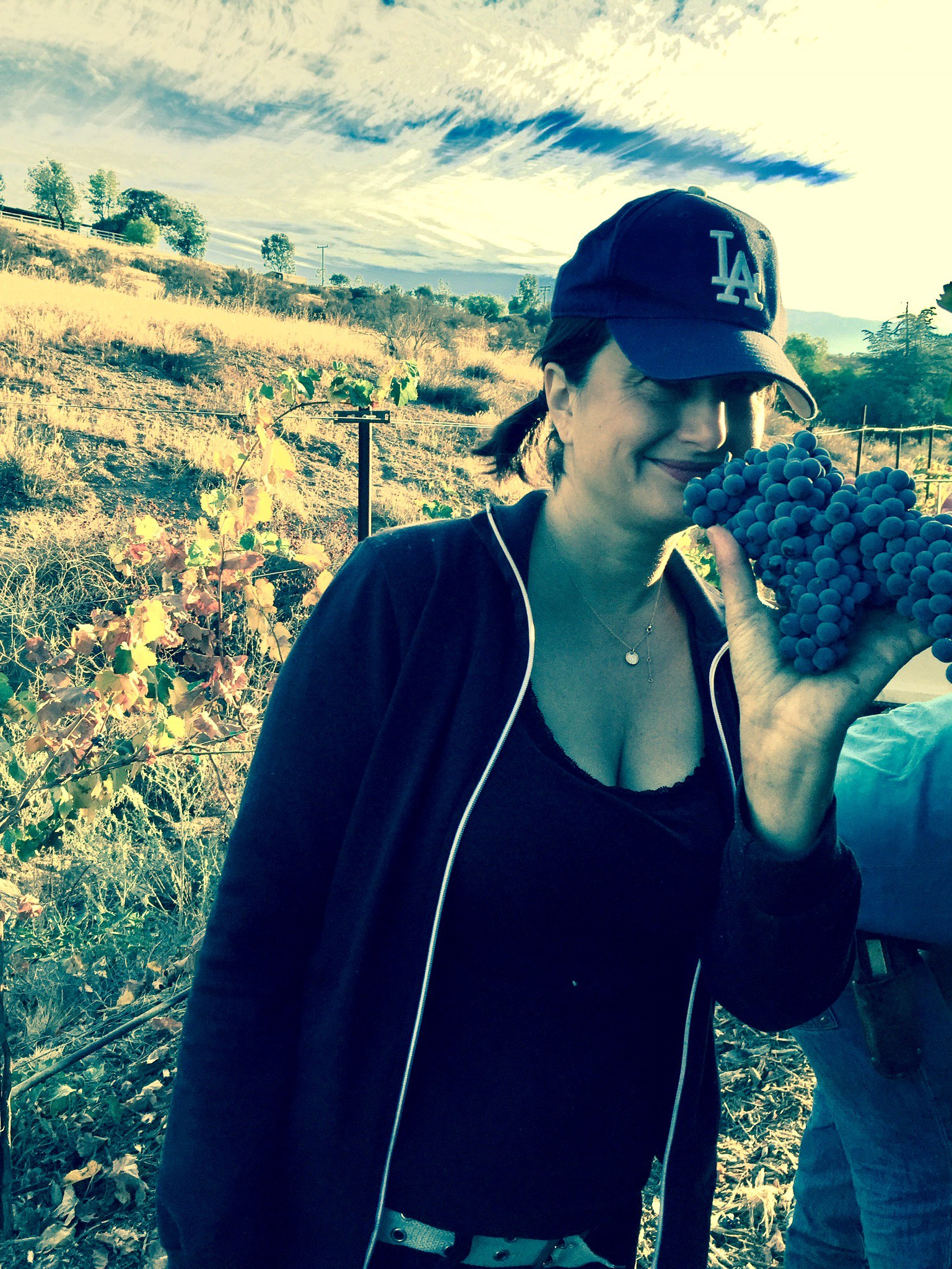
Amy Luftig, along with Jasper Dickson, operates Angeleno Wine Co., which makes a fortified wine using grapes from the Ramona vine growing at the San Gabriel Mission. Photo courtesy of Angeleno Wine Co.
They pick the Ramona Vine's grapes, a process that takes most of the day, then bring them back to the winery. There, they press the juice and fortify it with brandy from The Spirit Guild, a distillery in DTLA's Arts District. "We wanted to keep it as local as possible," Luftig says. "We fortify the freshly pressed juice so that the juice never ferments into a traditional wine. You end up with this really cool, sort of sweet, almost cordially dessert wine that has so much complexity of flavor. It's incredible."
Unfortunately, the harvest doesn't yield many bottles. "There's only a very small amount of it. The grapes are so small and there are so few of them on each branch that we end up only getting about half or three-quarters of a barrel of Angelica every year," Luftig says.
Angeleno Wine Co. plans to release Angelica at some point this spring or summer. They'll probably offer it first to members of their wine club. If there's any left, they'll sell it to the general public.
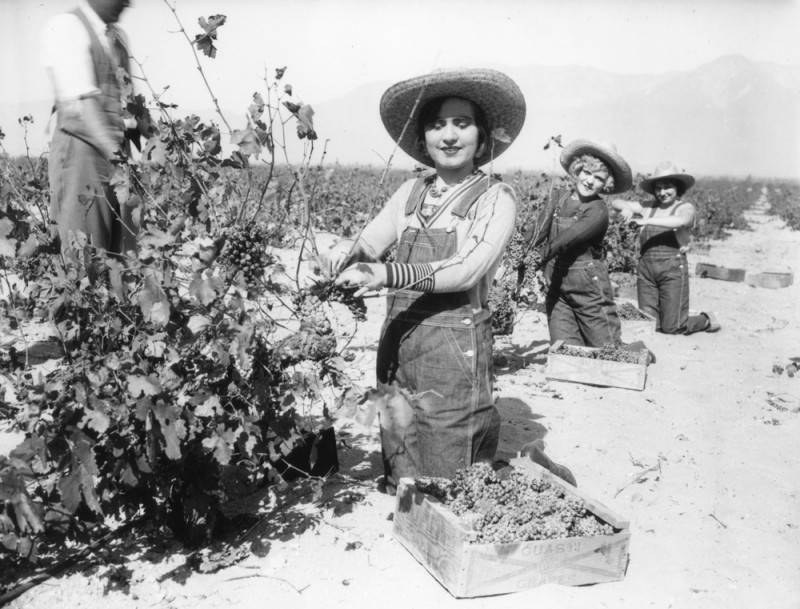
Three women pick grapes at the Guasti vineyard, in the Cucamonga Valley, in 1929. Photo via the Eyre Powell Chamber of Commerce Collection/Los Angeles Public Library Collection
If you can't get your hands on Angelica, Angeleno Wine Co. has other options, all of which honor the history of Los Angeles as much as they pay tribute to the craft of winemaking.
In fact, she and Dixon first heard about the Ramona Vine from one of their growers, Juan Alonso, who owns the Alonso Family Vineyards in Agua Dulce and Le Chène, a French restaurant in nearby Santa Clarita.
"Jasper actually met [Juan] first," Luftig says. "He tried a wine that was made from grapes that were picked at the vineyard. And when Jasper tried this wine and learned that the grapes came from LA, he reached out to Juan and went up to visit the vineyard and slowly started picking fruit from him."
Angeleno Wine Co. produced their first vintage in 2015. As they've ramped up production, they've found other local vineyards that they've fallen in love with.
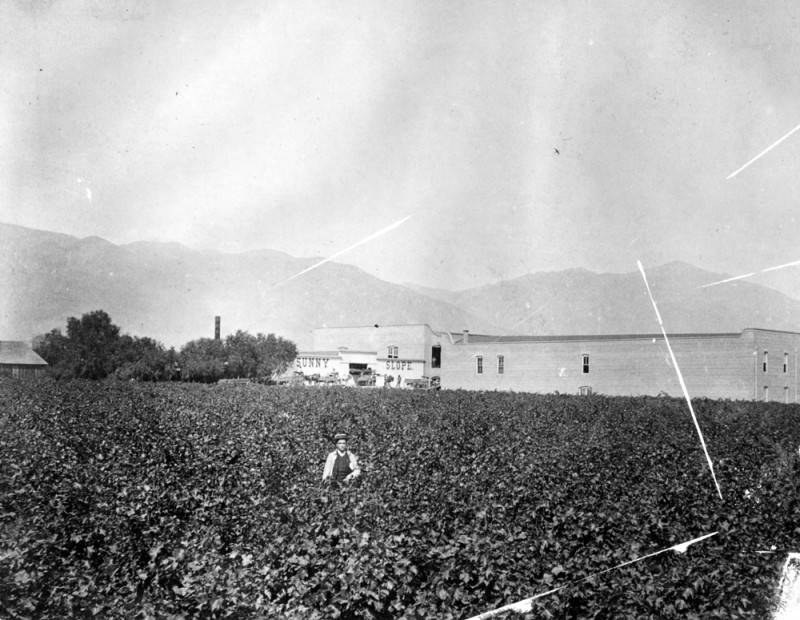
The Sunny Slope Vineyard in Pasadena was owned by L.J. Rose. Date unknown. Photo via the Security Pacific National Bank Collection/Los Angeles Public Library Collection
"Most of the vineyards that we work with are in the more rural parts of Los Angeles County. Some of them are up in the Antelope Valley. We've been working with an incredible vineyard that dates back to the mid-1800s called the Lopez Vineyard, which is out in Rancho Cucamonga. It's technically, right on the border of LA County [in San Bernardino County], but just a stone's throw away. And we continue to learn about these little pockets of vineyards, some of them very old, some of them newer."
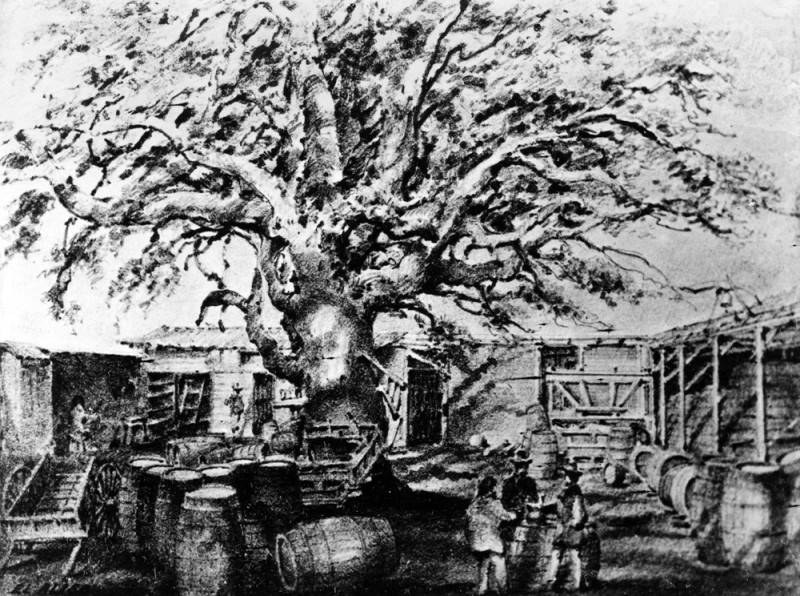
This photo of a drawing by Edward Vischer of El Aliso depicts the old Vignes wine establishment. The date is unknown. Photo via the Los Angeles Public Library Collection
Before they launched Angeleno Wine Co., Luftig and Dixon did a fair bit of research about the city's winemaking history. Luftig points out how Vignes Street, behind Union Station, is named after Jean-Louis Vignes, the earliest commercial (i.e. non-religious) winemaker in L.A. Arriving from Bordeaux, France, he found a promising plot of land in downtown L.A., put down roots and began producing wine.
His winery was called El Aliso, after a sycamore tree that grew on the property. "We have his sycamore tree at the center of our logo, and most of our bottles are the shape of the bottles that he probably would have been bottling in," Luftig says. "It's a long way of saying that woven throughout whatever we do here at Angeleno, we always want to try and honor the ones who came before us and pass on the very important message that we are the birthplace of winemaking here in California and we should be proud of our winemaking history."
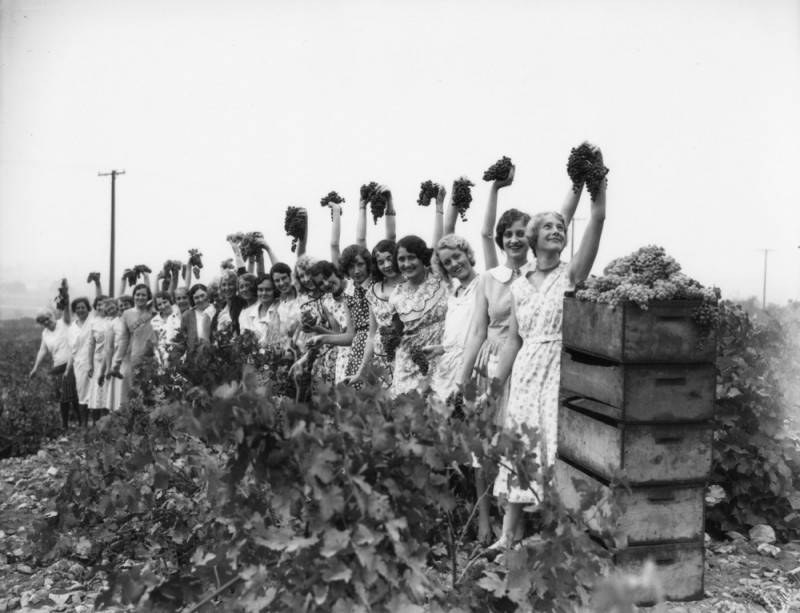
Women show off grapes they've picked in a Burbank vineyard, circa 1928. Photo via the Eyre Powell Chamber of Commerce Collection/Los Angeles Public Library Collection
LISTEN: This downtown winery is the first to open in LA since Prohibition

